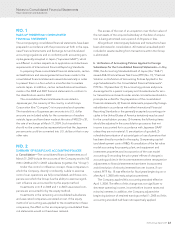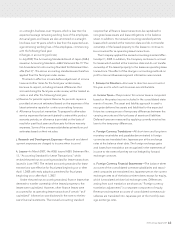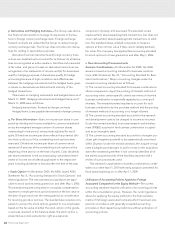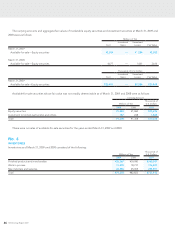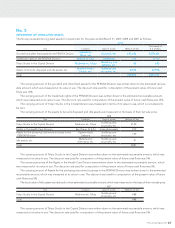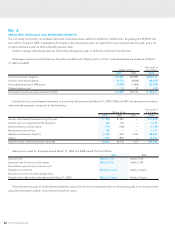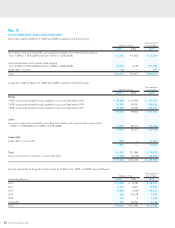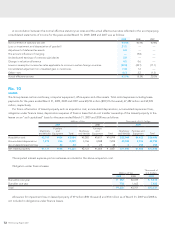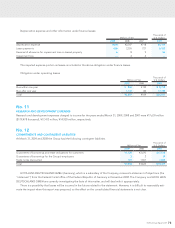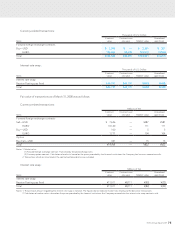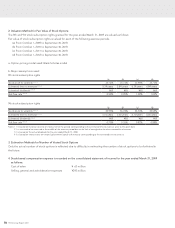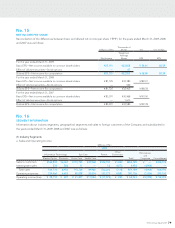Pentax 2009 Annual Report Download - page 71
Download and view the complete annual report
Please find page 71 of the 2009 Pentax annual report below. You can navigate through the pages in the report by either clicking on the pages listed below, or by using the keyword search tool below to find specific information within the annual report.
69
HOYA Annual Report 2009
No. 7
EQUITY
Since May 1, 2006, Japanese companies have been subject to
the Companies Act of Japan (the “Companies Act”). The sig-
nificant provisions in the Companies Act that affect financial and
accounting matters are summarized below:
(a) Dividends
Under the Companies Act, companies can pay dividends at any
time during the fiscal year in addition to the year-end dividend
upon resolution at the shareholders meeting. For companies
that meet certain criteria such as; (1) having the Board of Direc-
tors, (2) having independent auditors, (3) having the Board of
Corporate Auditors, and (4) the term of service of the directors
is prescribed as one year rather than two years of normal term
by its articles of incorporation, the Board of Directors may
declare dividends (except for dividends in kind) at any time
during the fiscal year if the company has prescribed so in its
articles of incorporation.
The Board of Directors of companies with board commit-
tees (The Nomination committee, Compensation committee
and Audit committee) can also do so because such companies
with board committees already, by nature, meet the above
criteria under the Companies Act, even though such compa-
nies have an audit committee instead of the Board of Corpo-
rate Auditors. The Company is organized as a company with
board committees.
The Companies Act permits companies to distribute
dividends-in-kind (non-cash assets) to shareholders subject to a
certain limitation and additional requirements.
The Companies Act provides certain limitations on the
amounts available for dividends or the purchase of treasury
stock. The limitation is defined as the amount available for dis-
tribution to the shareholders, but the amount of net assets after
dividends must be maintained at no less than ¥ 3 million.
On May 28, 2009, the Board of directors resolved cash divi-
dends amounting to ¥15,150 million ($154,230 thousand). Such
appropriations have not been accrued in the consolidated
financial statements as of March 31, 2009. Such appropriations
are recognized when the Board of directors resolves them.
(b) Increases/decreases and transfer of common stock,
reserve and surplus
The Companies Act requires that an amount equal to 10% of
dividends must be appropriated as a legal reserve (a compo-
nent of retained earnings) or as additional paid-in capital (a
component of capital surplus) depending on the equity account
charged upon the payment of such dividends until the total of
aggregate amount of legal reserve and additional paid-in capi-
tal equals 25% of the common stock. Under the Companies Act,
the total amount of additional paid-in capital and legal reserve
may be reversed without limitation. The Companies Act also
provides that common stock, legal reserve, additional paid-in
capital, other capital surplus and retained earnings can be
transferred among the accounts under certain conditions upon
resolution of the shareholders.
(c) Treasury stock and treasury stock subscription rights
The Companies Act also provides for companies to purchase
treasury stock and dispose of such treasury stock by resolution
of the Board of Directors. The amount of treasury stock pur-
chased cannot exceed the amount available for distribution to
the shareholders which is determined by specific formula.
Under the Companies Act, stock subscription rights, are
presented as a separate component of equity.
The Companies Act also provides that companies can pur-
chase both treasury stock subscription rights and treasury stock.
Such treasury stock subscription rights are presented as a sepa-
rate component of equity or deducted directly from stock sub-
scription rights.




